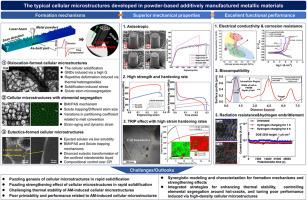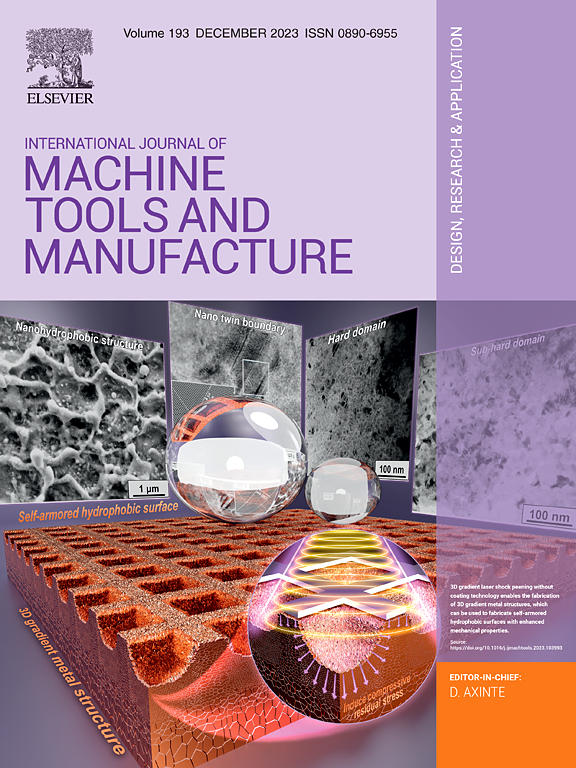The typical cellular microstructures developed in powder-based additively manufactured metallic materials: formation mechanisms, properties, outlooks and challenges
IF 18.8
1区 工程技术
Q1 ENGINEERING, MANUFACTURING
International Journal of Machine Tools & Manufacture
Pub Date : 2025-09-05
DOI:10.1016/j.ijmachtools.2025.104332
引用次数: 0
Abstract
Cellular microstructures are intrinsically associated with the printability and mechanical-functional performance of laser-additively manufactured metallic materials. An in-depth understanding of formation mechanisms under extreme processing conditions and impacts on mechanical-functional performance remains critical to improving the application prospects of laser additive manufacturing. In this paper, vital insights into the characteristics, formation mechanisms, mechanical-functional performance, and prospects of cellular microstructures are orchestrated and articulated. First, the differences between dislocation cellular microstructures obtained from conventional methods and those induced by additive manufacturing are summarised through a comparative analysis. Based on the diverse environments of sub-boundaries, almost all cellular microstructures in metallic materials are then exemplified and classified into three categories: dislocation-formed cellular microstructures, both with and without elemental segregation, and eutectic-formed cellular microstructures. For each category, its formation mechanisms related to analysis approaches and evaluation of mechanical-functional performance are delineated and discussed in detail. Finally, insights into the formation mechanisms, model development, thermal stability of cellular microstructures, and countermeasures for aspects of their negative influence on printability and performance are presented. Collectively, this systematic review of cellular microstructures provides a foundational framework to guide the design, manufacture, and industrial-scale implementation of high-performance metallic components.

粉末基增材制造金属材料中典型的细胞微结构:形成机制、性能、前景和挑战
细胞微结构与激光增材制造的金属材料的可打印性和机械功能性能有着内在的联系。深入了解极端加工条件下的形成机制及其对机械功能性能的影响对于提高激光增材制造的应用前景至关重要。在本文中,对细胞微结构的特征、形成机制、机械功能性能和前景的重要见解进行了编排和阐述。首先,通过对比分析,总结了传统方法获得的位错细胞微观结构与增材制造方法获得的位错细胞微观结构之间的差异。基于不同的亚边界环境,对金属材料中几乎所有的细胞微结构进行了举例,并将其分为三类:位错形成的细胞微结构(包括元素偏析和不存在元素偏析的细胞微结构)和共晶形成的细胞微结构。对于每个类别,其形成机制与分析方法和评估的机械功能性能进行了详细的描述和讨论。最后,介绍了细胞微结构的形成机制、模型开发、热稳定性以及它们对打印性能和性能的负面影响的对策。总的来说,这种对细胞微结构的系统回顾为指导高性能金属部件的设计、制造和工业规模实施提供了基础框架。
本文章由计算机程序翻译,如有差异,请以英文原文为准。
求助全文
约1分钟内获得全文
求助全文
来源期刊
CiteScore
25.70
自引率
10.00%
发文量
66
审稿时长
18 days
期刊介绍:
The International Journal of Machine Tools and Manufacture is dedicated to advancing scientific comprehension of the fundamental mechanics involved in processes and machines utilized in the manufacturing of engineering components. While the primary focus is on metals, the journal also explores applications in composites, ceramics, and other structural or functional materials. The coverage includes a diverse range of topics:
- Essential mechanics of processes involving material removal, accretion, and deformation, encompassing solid, semi-solid, or particulate forms.
- Significant scientific advancements in existing or new processes and machines.
- In-depth characterization of workpiece materials (structure/surfaces) through advanced techniques (e.g., SEM, EDS, TEM, EBSD, AES, Raman spectroscopy) to unveil new phenomenological aspects governing manufacturing processes.
- Tool design, utilization, and comprehensive studies of failure mechanisms.
- Innovative concepts of machine tools, fixtures, and tool holders supported by modeling and demonstrations relevant to manufacturing processes within the journal's scope.
- Novel scientific contributions exploring interactions between the machine tool, control system, software design, and processes.
- Studies elucidating specific mechanisms governing niche processes (e.g., ultra-high precision, nano/atomic level manufacturing with either mechanical or non-mechanical "tools").
- Innovative approaches, underpinned by thorough scientific analysis, addressing emerging or breakthrough processes (e.g., bio-inspired manufacturing) and/or applications (e.g., ultra-high precision optics).

 求助内容:
求助内容: 应助结果提醒方式:
应助结果提醒方式:


